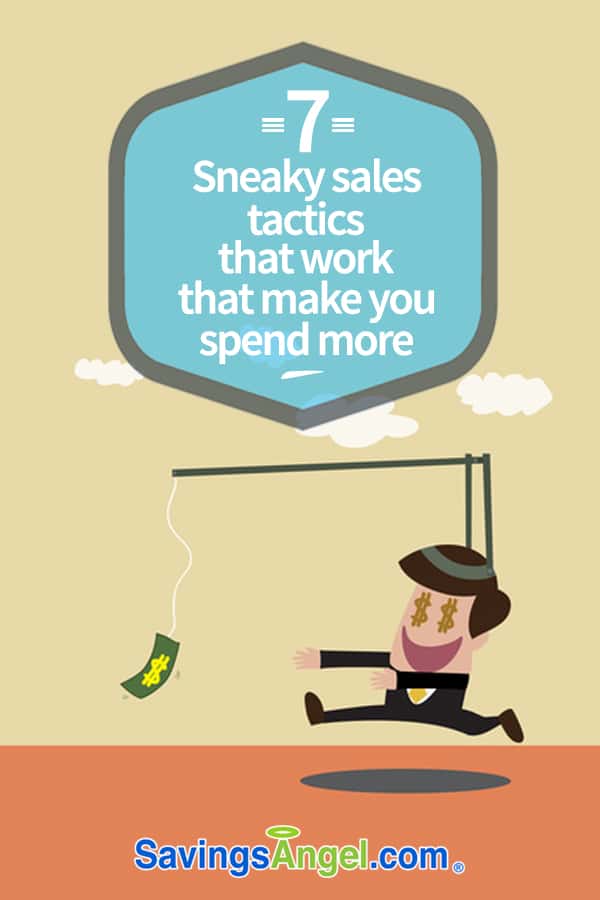 We’ve all done it. It happens more often than we like. We get to the register and wonder how we ended up shelling out more money than we expected. This had me thinking about all the sly sales tactics that work on consumers to get you to spend more.
We’ve all done it. It happens more often than we like. We get to the register and wonder how we ended up shelling out more money than we expected. This had me thinking about all the sly sales tactics that work on consumers to get you to spend more.
Here are seven sly (yet totally legal) sales tactics that work for retailers and end up costing you more money.
Sales tactics that work #1
Brand look-alikes
It’s pretty common for a store brand or off brand item to be packaged to look like it’s name brand counterpart. When we are in a rush, distracted, or not paying close enough attention, it’s easy to mix up the non-sale item with the one that’s on sale. After all, they are placed right next to each other.
Unless you watch closely at the register, often times you don’t realize your mistake until you’re unpacking your groceries at home. You can always go back and return your over-priced items, but how many of us take the time and effort to actually do that?
Sales tactics that work #2
Sales that only apply to very specific sizes or types
This is just as common as grabbing the wrong brand. When you pick up the wrong sale size or type of shampoo, for example, oops — you just paid more!
Sales tactics that work #3
Offering points in place of money-off
Offering bonus points on certain purchases that can be “cashed in” later. One drug store chain lets you rack up bonus points on your loyalty card that can then be redeemed for discounts on future purchases. What you might not be aware is there may be a limit to the points you can earn, points can expire, or can’t be redeemed on prescriptions or other specified items.
Other stores might advertise sales but limit you to one offer per transaction. Be sure to carefully read the fine print on ad signs or, in the case of loyalty programs, review the terms of use to be sure you know any limits on promotional offers.
Sales tactics that work #4
Requiring a store loyalty card
Many grocery and drugstores stores across the U.S. require the use of loyalty cards to get a discount. This has become commonplace. The sale signs in these stores advertise the sale prices in large print but those prices only apply to loyalty card holders.
If you are shopping in a new store, stop by the customer service counter first and see if you need a card before you end up with a shockingly large total in the check-out lane. This can easily happen if you’re traveling and are unfamiliar with the store chain. However, I know from experience that oftentimes the cashier has a “guest” card that they will swipe for you if you explain that you are not from that area.
Sales tactics that work #5
Quantity purchase pricing
You’ve probably heard that if an item is sale priced at 2/$4, you usually don’t have to buy two items to get the sale price. Instead, you can buy one at $2.00.
However, it appears some retailers are turning the tables on this tactic. I am increasingly seeing retailers who have, for example, a sale price of 2/$4 and then write in tiny print “single item pricing $2.49″ or something similar.
It seems they are now counting on people picking up a single item so they can hit them with a higher price at check-out. As long as they have that small print saying there is a separate single item price, this tactic is perfectly legal. That means you’ll want to quick look at the sale sign before making your purchase.
And then there’s the $5 off when you purchase 5 items, types of sales. With sales like this, there’s no getting around having to buy more in order to get the discount.
Sales tactics that work #6
Discounts on a future purchase
Another tactic is to offer you money off a future purchase rather than a discount at the register. It could come in the form of a custom coupon or a discount added to a loyalty card.
Either way, the store is sure to come out ahead. Either you forget to use the coupon before it expires, or you make a return trip and possibly buy more than you had planned.
There’s nothing wrong with taking advantage of a deal that includes a discount off a future purchase, but be sure it’s a store you regularly shop. It doesn’t make sense to go far out of your way specifically for a deal like this.
Sales tactics that work #7
Offer rebates
Finally, stores may offer rebates with the hope you will forget to mail in for your money back. According to 2011 research, 47% of consumers submitted a rebate, meaning 53% were unredeemed. Current figures on how many rebates go unredeemed is difficult to come by.
Regardless of the actual number, be aware a deal with a rebate attached may not be a deal if you fail to claim your rebate check.
In the end, retailers aren’t in the business of trying to save you as much as possible. No, they would like you to spend as much as possible. Knowing their sneaky ways to get you to buy more is the first step toward paying less.


